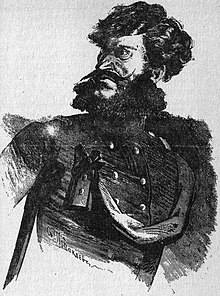
Back طرفة الكلب الأشعث Arabic Stori asgwrn pen llo CY Yarn German Histoire sans queue ni tête French シャギー・ドッグ・ストーリー Japanese Västgötaklimax Swedish 长毛狗的故事 Chinese
| Shaggy-dog story | |
|---|---|
 Captain Kopeikin, illustration by Pyotr Boklevsky; a fictional character from Gogol's Dead Souls who tells a shaggy dog story. |
In its original sense, a shaggy-dog story or yarn is an extremely long-winded anecdote characterized by extensive narration of typically irrelevant incidents and terminated by an anticlimax. In other words, it is a long story that is intended to be amusing and that has an intentionally silly or meaningless ending.[1]
Shaggy-dog stories play upon the audience's preconceptions of joke-telling. The audience listens to the story with certain expectations, which are either simply not met or met in some entirely unexpected manner.[2] A lengthy shaggy-dog story derives its humour from the fact that the joke-teller held the attention of the listeners for a long time (such jokes can take five minutes or more to tell) for no reason at all, as the long-awaited resolution is essentially meaningless, with the joke as a whole playing upon humans' search for meaning.[3][4] The nature of their delivery is reflected in the English idiom spin a yarn, by way of analogy with the production of yarn.
As a comic device, the shaggy-dog story is related to unintentional long windedness, and the two are sometimes both referred to in the same way. While a shaggy-dog story is a comic exaggeration of the real life experience, it is also deliberately constructed to play off an audience who are expecting a comedic payoff and uses that expectation to subvert expectations and create comedy in unexpected ways. In such kind of humorous story, the humor lies in the pointlessness or irrelevance of the plot or punch line.[5]
Humanities scholar Jane Marie Todd observed that the shaggy-dog story demonstrates the nature of desiring humor and how that process occurs.[4]
- ^ "shaggy-dog story Meaning in the Cambridge English Dictionary". Archived from the original on 11 September 2015. Retrieved 5 January 2025.
- ^ Cohen, Ted (1999). Jokes. University of Chicago Press. p. 8. ISBN 0-226-11230-6.
- ^ Jovial Bob Stine (1978). How to be funny: an extremely silly guidebook. Dutton. ISBN 0-525-32410-0.
- ^ a b Todd, Jane Marie (1992). "Balzac's Shaggy Dog Story". Comparative Literature. 44 (3): 268–279. doi:10.2307/1770857. ISSN 0010-4124. JSTOR 1770857.
- ^ "Definition of SHAGGY-DOG".